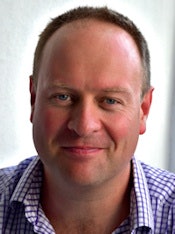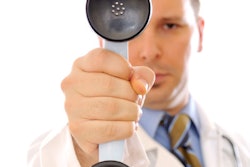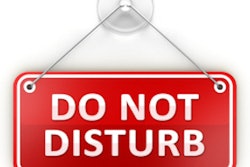
Reflection and navel-gazing is something of an increasing personal hobby or affliction, depending on how you look at it. As I'm only in my early 40s, I don't think it is a function of aging. I like to think of it as a "physician, know thyself" kind of thing. At any rate, the phenomenon of interruptions has recently struck me as unique and worthy of discourse.
Interruptions are the many disturbances that a radiologist endures whilst trying to report. Reporting activity is everything these days. Gone are the days when the worth of a radiologist was their sound opinions, the eloquence and lucidity of their reports, their humanistic qualities, and their abilities as a teacher, researcher, and all-round good egg. If you ain't shifting a thousand plain films a month, then you ain't worth nuffin'. At least that is how it feels, even if your clinical director denies it emphatically.
 Dr. Paul McCoubrie is a consultant radiologist at Southmead Hospital in Bristol, U.K.
Dr. Paul McCoubrie is a consultant radiologist at Southmead Hospital in Bristol, U.K.This leads to slight tensions arising when you can't seem to get any "proper" work done. After the nth ward round has taken in your PACS reporting station as their last stop that morning, if you listen carefully you can hear a vague swooshing sound as your reporting target whistles past.
Now there is no doubt that it is annoying to have your intellectual reverie shattered. The possible exception to this is the appearance of a colleague wanting to chew the proverbial radiological fat for five minutes. Not only is this usually a welcome break, but also I regard it as valuable in-house continuing professional development.
Typically, though, the interruption comes midway through the oncology case with monthly pan-body investograms spanning a seven-year history with 16 separate index lesions. However, when using basal ganglia alone to report the seemingly endless in-patient chest films, the prospect of re-engaging the cortex via human contact and conversation is often appreciated.
A knock on the door or polite cough is the usual announcement. The more senior and, well, surgical, the noisier the arrival. Locally, we have a neurosurgeon who announces his presence in the form of song -- I kid you not. However, some folks sidle in completely soundlessly and you become aware of their presence by some bizarre sixth sense. Sometimes I feel like Haley Joel Osment when an indescribable sensation alerts me to the presence of four soundless juniors hovering behind me.
The interloper typically opens with, "Can I ask you a question?" I have tried the answer, "And your second question is?" but most blink momentarily at this repartee, petit mal-like, before launching into their prepared spiel. The other classic of, "Can I disturb you?" can be countered with, "Didn't give me much of a chance there, did you?" Witty as it may seem, no one has ever laughed with 100% honesty at that one either. Their expressions are usually that of bewildered pity.
The task that is asked is usually inversely related to the time you have available. Most mornings will only see trivial queries about Mrs. Lard's bunion-ogram, whereas a referral at 4:55 on Friday afternoon usually involves someone very young, very complex, and very, very sick. On the birthdays of the spouses or beloved offspring, all hell tends to break loose bang-on quitting time, whereupon you find yourself mysteriously without a single colleague in the entire department.
A variable length of time later, the trespasser has departed; your cup of tea has gone from lukewarm to stone-cold and your mental radiology cache has autodeleted. You sigh audibly, mentally ruminate about the precise dates of your next booked annual leave, and then turn back to the tombstone-like PACS monitors to start afresh.
It is perhaps understandable that radiologists have evolved dysfunctional working practices to avoid interruptions. Some of these changes are working practice arrangements; some are geographical alterations. At worst, I've heard of radiologists who shut doors in juniors' faces. However, I think it is unprofessional to place rude signs on doors or hide behind locked doors.
I'm not totally decided whether changing reporting behavior to cope with interruptions is sensible. By this I mean some radiologists now deliberately come in at odd times to get some plain-film reporting done whilst it is quiet. Some even deliberately seek out the quieter PACS reporting stations to reduce the chance of being disturbed. It won't be long before folks are campaigning to report from home via a teleradiology link for the same reasons. It's only OK if the rest of us aren't left stranded, toiling alone at the coal face.
What I am taking a long way round to saying is that I think we shouldn't call them interruptions. A change in ethos is needed -- we should call them "consultations." Maybe the clue is in the name, but consultants are there to be consulted. It's not original, but I try to remind junior doctors that we should always try to help our clinical colleagues -- or at least appear to be helping, which is a subtle but crucial difference.
Dr. Paul McCoubrie is a consultant radiologist at Southmead Hospital in Bristol, U.K.
The comments and observations expressed herein do not necessarily reflect the opinions of AuntMinnieEurope.com, nor should they be construed as an endorsement or admonishment of any particular vendor, analyst, industry consultant, or consulting group.



















